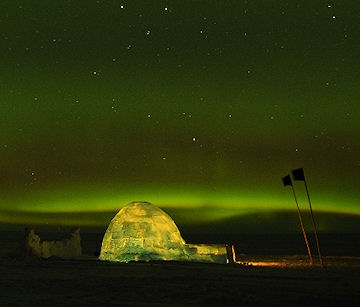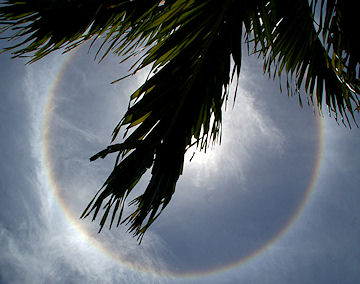NEW AND IMPROVED: Turn your iPhone or iPod Touch into a field-tested global satellite tracker. The Satellite Flybys app now works in all countries. | | | THE ASTRONOMY OF MOTHER'S DAY: Do you dare wake Mom at dawn ... on Mother's Day? Under the circumstances, she might not mind. May 9th begins and ends with a lovely display of stars and planets. Get the full story from Science@NASA. GEOGRAPHY QUIZ: Where do people speak German and the sky turns green for as much as 20 hours a day? The answer lies beneath the igloo: 
Photo details: Nikon D300, ISO 400, 11mm, F2.8, 30s exposure
It's the Neumayer Station, a German research outpost on the Ekström Ice Shelf Ice in coastal Antarctica. Geophysicist Sara Huber is working there and she took the picture on April 11th just after a coronal mass ejection (CME) hit Earth's magnetic field. The aurora australis grew so bright, the snowy ground and even the igloos reflected their green glow. It could happen again this weekend. NOAA forecasters estimate a 20% chance of geomagnetic activity on May 8th when a CME might deliver a glancing blow to Earth's magnetic field. High-latitude sky watchers should be alert for auroras. May 2010 Aurora Gallery
[previous Mays: 2008, 2005, 2004, 2003, 2002] [aurora alerts] DON'T BE ALARMED: "At lunchtime today, my workers were in a panic," says Christopher Go of Cebu City, the Philippines. "There's a weird ring around the sun, they said. I told them to calm down. It's just an ice halo." 
That's right, ice. Although it was hot and muggy in Cebu City today, there was ice in the air. About 10 km above the ground, the temperature dropped below freezing, causing water in the clouds to crystalize. The halo appeared when sunlight hit those crystals. Ice crystals come in many shapes and sizes, and they can make many kinds of sun halos. "This particular halo is called a circumscribed halo," says atmospheric optics expert Les Cowley. "It is sharp and brightly coloured - both symptoms of a circumscribed arc." "Sun halos are visible all over the world and throughout the year," adds Les Cowley. "Look for them whenever the sky is wisped or hazed with thin cirrus clouds. These clouds are cold and contain ice crystals in even the hottest climes." more images: from Sigurd Lasa of Cebu City, Philippines; from Lenny Shaffer of Lewes, Delaware | 
